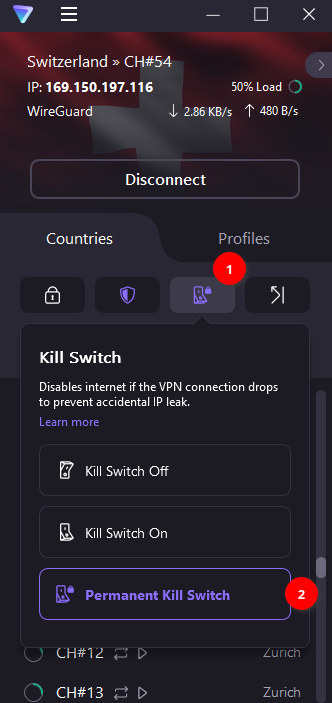As discussed in Always stay secure with our permanent kill switch, our permanent kill switch feature prevents your device from connecting to the internet unless it is connected to a Proton VPN server.
The permanent kill switch is available on our Windows and Linux apps. It should also be noted that when you configure a kill switch on Android, it works in a similar way to the permanent kill switch, rather than a regular kill switch.
What is a permanent kill switch?
Our permanent kill switch ensures that you do not accidentally connect to the internet without a Proton VPN connection. Like the similar kill switch feature, the permanent kill switch will disable your internet connection during accidental VPN dropouts until a connection can be automatically re-established.
Unlike the kill switch, it also prevents you from accidentally using the internet without the VPN turned on, and it will persist when you shut down and restart your system. You will not be able to connect to the internet if you manually disconnect the VPN without also disabling the permanent kill switch.
- The kill switch only works when you are connected to the VPN
- The permanent kill switch works at all times, even if you manually disconnect the VPN
Whether you should use the kill switch or the permanent kill switch will depend on your needs and threat model. Both kill switches will protect you against accidental VPN dropouts, but permanent kill switch provides additional protection by ensuring you never accidentally access the internet without the VPN enabled.
However, the regular kill switch might be a better option if you sometimes want to access the internet without a VPN.
To enable the permanent kill switch
Open the Proton VPN app for Windows or Linux and:
- Click the Kill Switch icon in the Quick Settings Bar.
- Select Permanent Kill Switch.
All internet connections into and out of your Windows device will now be blocked unless a VPN connection to a Proton VPN server is active.

To disable the permanent kill switch
Open the Proton VPN app for Windows or Linux and:
- Click the Kill Switch icon in the Quick Settings Bar.
- Select Kill Switch Off (or Kill Switch On to use the regular non-persistent kill switch instead).
You must disable the permanent kill switch to connect to the internet without an active VPN connection.
Sign up for a Proton VPN Free plan for Windows or Linux to try the permanent kill switch.
FAQ
Do I have to manually reconnect the VPN if the permanent kill switch is enabled?
The Proton VPN app Windows and Linux will always automatically try to reconnect to the last VPN server in the event of an accidental disconnection (whether or not either kill switch is used).
If you manually disconnect the VPN, then you’ll need to either manually reconnect to a VPN server or turn the Kill Switch Off before your device can use the internet again.
Help! I can’t access the internet. What should I do?
If permanent kill switch is enabled, your device won’t be able to access the internet until you either connect to a Proton VPN server or disable the permanent kill switch.
Does the permanent kill switch protect me when booting up or shutting down my PC or Windows tablet?
Yes. On Windows, permanent kill switch creates persistent filters using the Windows Filtering Platform to prevent all internet connections outside the VPN interface. These filters remain in place when you start up, shutdown, or reboot your device. On Linux, we create a dummy network interface and redirect all outgoing traffic there to ensure no outside connections are possible.


